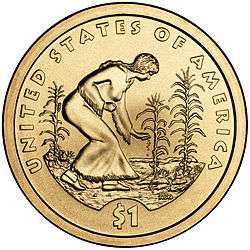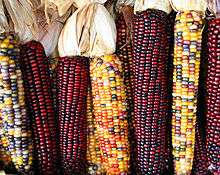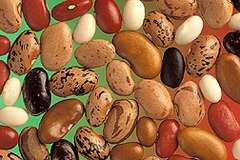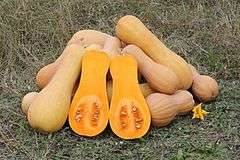Three Sisters (agriculture)

The Three Sisters are the three main agricultural crops of various Native American groups in North America: winter squash, maize (corn), and climbing beans (typically tepary beans or common beans). Originating in Mexico, these three crops were carried northward, up the river valleys over generations of time, far afield to the Mandan and Iroquois who, among others, used these "Three Sisters" as trade goods.
In a technique known as companion planting the three crops are planted close together. Flat-topped mounds of soil are built for each cluster of crops.[1] Each mound is about 30 cm (12 in) high and 50 cm (20 in) wide, and several maize seeds are planted close together in the center of each mound. In parts of the Atlantic Northeast, rotten fish or eels are buried in the mound with the maize seeds, to act as additional fertilizer where the soil is poor.[2] When the maize is 15 cm (6 inches) tall, beans and squash are planted around the maize, alternating between the two kinds of seeds. The process to develop this agricultural knowledge took place over 5,000–6,500 years. Squash was domesticated first, with maize second and then beans being domesticated.[3][4] Squash was first domesticated 8,000–10,000 years ago.[5][6]
The three crops benefit from each other. The maize provides a structure for the beans to climb, eliminating the need for poles. The beans provide the nitrogen to the soil that the other plants use, and the squash spreads along the ground, blocking the sunlight, helping prevent the establishment of weeds. The squash leaves also act as a "living mulch", creating a microclimate to retain moisture in the soil, and the prickly hairs of the vine deter pests. Corn, beans, and squash contain complex carbohydrates, essential fatty acids and all eight essential amino acids, allowing most Native American tribes to thrive on a plant-based diet.[7]
Native Americans throughout North America are known for growing variations of Three Sisters gardens.[8] The milpas of Mesoamerica are farms or gardens that employ companion planting on a larger scale.[9] The Ancestral Puebloans are known for adopting this garden design in a drier environment. The Tewa and other peoples of the Southwestern United States often included a "fourth Sister", Rocky Mountain bee plant (Cleome serrulata), which attracts bees to help pollinate the beans and squash.[10]
The Three Sisters planting method is featured on the reverse of the 2009 US Sacagawea dollar.[11]
Cahokian, Mississippian and Mvskoke culture
Corn, squash and beans were planted ca. 800 ce in the largest Native American city north of the Rio Grande known as Cahokia, in what is now known as the US state of Illinois, across the river from St Louis, Missouri. The Three Sisters crops were responsible for the surplus food that created an expanded population throughout the extended Mississippi River valley and tributaries, creating the Mississippian and Mvskoke cultures that flourished from ca. 800 ce to ca. 1600 when physical contact with spanish explorers brought european disease, death and cultural collapse.
Iroquois and Seneca culture
The division of labor among the Iroquois and Seneca peoples was noted to be that women tended the crops, the 'three sisters'. This was because men could be absent from their home and villages for an extended amount of time while hunting, attending diplomatic missions and raiding. The initial preparation for the planting of the 'three sisters' was performed by the men who cleared the land. After the land was cleared, groups of women who were related to each other would then do the planting, weeding and harvesting.[12]
Gallery


 Butternut squash, a type of winter squash.
Butternut squash, a type of winter squash.
See also
References
- ↑ Mt. Pleasant, Jane (2006). "38". In John E. Staller; Robert H. Tykot; Bruce F. Benz. The science behind the Three Sisters mound system: An agronomic assessment of an indigenous agricultural system in the northeast. Histories of Maize: Multidisciplinary approaches to the prehistory, linguistics, biogeography, domestication, and evolution of maize. Amsterdam: Academic Press. pp. 529–537. ISBN 978-1-5987-4496-5.
- ↑ Vivian, John (February–March 2001). "The Three Sisters". Mother Earth News. Retrieved September 18, 2013.
- ↑ Landon, Amanda J. (2008). "The "How" of the Three Sisters: The Origins of Agriculture in Mesoamerica and the Human Niche". Nebraska Anthropologist. Lincoln, NE: University of Nebraska-Lincoln: 110–124.
- ↑ Bushnell, G. H. S. (1976). "The Beginning and Growth of Agriculture in Mexico". Philosophical Transactions of the Royal Society of London. London: Royal Society of London. 275 (936): 117–120. doi:10.1098/rstb.1976.0074.
- ↑ Smith, Bruce D. (May 1997). "The Initial Domestication of Cucurbita pepo in the Americas 10,000 Years Ago". Science. Washington, DC: American Association for the Advancement of Science. 276: 932–934. doi:10.1126/science.276.5314.932.
- ↑ "Cucurbitaceae--Fruits for Peons, Pilgrims, and Pharaohs". University of California at Los Angeles. Archived from the original on October 16, 2013. Retrieved September 2, 2013.
- ↑ McDougall, John (2002). "Misinformation on Plant Proteins". Circulation. Dallas, Tx: American Heart Association. 106 (20): e148--e148. doi:10.1161/01.CIR.0000018905.97677.1F.
- ↑ Wilson, Gilbert (1917). Agriculture of the Hidatsa Indians: An Indian Interpretation. Gloucestershire: Dodo Press. p. 25. ISBN 978-1409942337.
- ↑ Mann, Charles (2005). 1491: New Revelations of the Americas Before Columbus. New York: Vintage Books. pp. 220–221. ISBN 978-1-4000-3205-1.
- ↑ Hemenway, Toby (2000). Gaia's Garden: A Guide to Home-Scale Permaculture. White River Junction, VT: Chelsea Green Publishing. p. 149. ISBN 1-890132-52-7.
- ↑ "2009 Native American $1 Coin". United States Mint. Retrieved September 18, 2013.
- ↑ Bilharz, Joy (2002). The Allegany Sebecas and Kinzua Dam : forced relocation through two generations. Lincoln, Neb. Chesham: University of Nebraska Press Combined Academic. p. 8. ISBN 9780803262034.
External links
- Companion Planting-Three Sisters, Old Farmer's Almanac
- Virtual Museum of Canada, The St. Lawrence Iroquoians — virtual exhibit that includes information on Iroquoian agriculture and the Three Sisters
